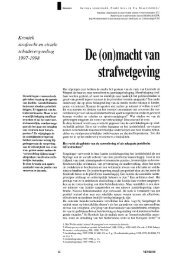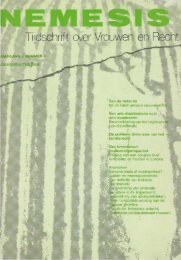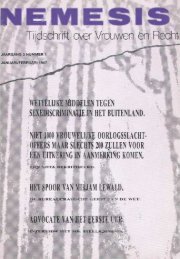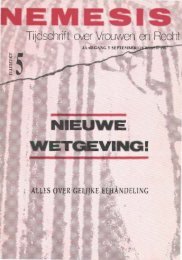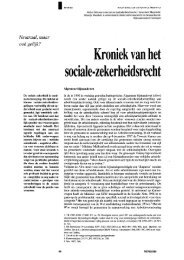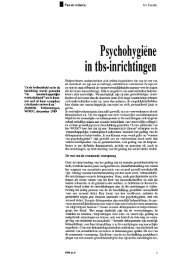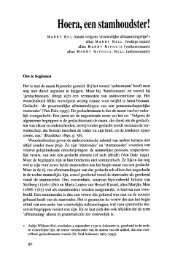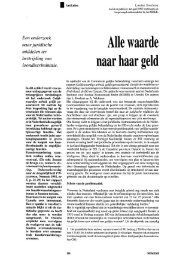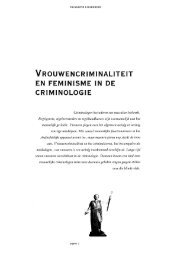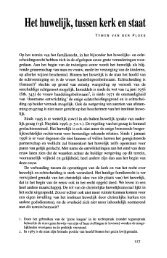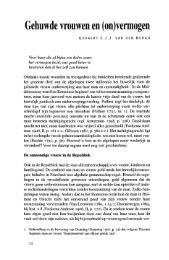(2001) nummer 1 januari/februari - Nemesis
(2001) nummer 1 januari/februari - Nemesis
(2001) nummer 1 januari/februari - Nemesis
You also want an ePaper? Increase the reach of your titles
YUMPU automatically turns print PDFs into web optimized ePapers that Google loves.
was 'ambiguous' when the sperm donor was known to<br />
the mother. The court found the statute only applied<br />
when the sperm donor was anonymous. Consequently,<br />
the Colorado Supreme Court stated that if the sperm<br />
donor is known to the mother, and the sperm donor alleges<br />
that he and the mother had an agreement that he<br />
would be considered the father, then the statutory provision<br />
does not operate automatically to prevent him<br />
from having a trial on that issue. 18<br />
It appears from a reading of the cases<br />
that U.S. courts will go to any length<br />
to grant known sperm donors legal<br />
parent status<br />
This court-created circumvention of the clear language<br />
of an AID statute was given even more strength in the<br />
Oregon case, 19 in which the court invoked constitutional<br />
protections for a sperm donor if he alleged he<br />
had an agreement with the mother in which he would<br />
be considered the child's legal parent. The Oregon<br />
AID statute was similar to the California statute because<br />
it provided for a physician to perform the insemination.<br />
It also stated that' [i]f the donor of semen used<br />
in the artificial insemination is not the mother's husband:<br />
(1) Such donor shall have no right, obligation or<br />
interest with respect to a child born as a result of the artificial<br />
insemination; and (2) A child born as a result of<br />
the artificial insemination shall have no right, obligation<br />
or interest with respect to the donor.' 20 The sperm<br />
donor alleged in his pleadings that, because no physician<br />
was involved in the insemination and because he<br />
was a known donor, the provisions of the statute that<br />
excluded him from legal parenthood did not apply in<br />
this case. Unlike the California and Colorado courts,<br />
the Oregon court rejected these two arguments. The<br />
Oregon appellate court found that the statute did not<br />
exclude the donor from its provisions if the parties<br />
failed to use a physician nor did the statutory language<br />
state the donor must be anonymous; the court held that<br />
to decide otherwise would 'rewrite the act'. 21 Although<br />
the Oregon Court of Appeals determined that the<br />
statute applied to the sperm donor, the court then struck<br />
down the statute as an unconstitutional violation of the<br />
due process rights of a sperm donor if it prevents him<br />
from alleging and proving that he donated his sperm in<br />
reliance on an agreement with the mother that he<br />
would have an active role in the child's life. Therefore<br />
18. Ho we ver, the court was clear that this interpretation of the statute<br />
only applied if the woman did not have a husband. The court determined<br />
that if the woman receiving the sperm had been married, then<br />
'an agreement that the donor would be the natural father is not a relevant<br />
consideration when the recipiënt is married and her husband<br />
consents in writing to the artificial insemination.' In re R. C. 775 P.2d<br />
at 33, Colo. 1989 (emphasis added). For a detailed description of the<br />
different treatment of unmarried and married women who use AID<br />
to coneeive children and suggested legislative changes to protect unmarried<br />
women, see Note,' A Tale of Three Women: A Survey of the<br />
Rights and Responsibilities of Unmarried Women who Coneeive by<br />
Alternative Insemination and a Model for Legislative Reform', 19<br />
Am.J.L. &Med. 285, 1993.<br />
19. Mclntyre, 780 P.2d 239, 83 ALR 4th 277, Or. App. 1989, rev. denied<br />
784 P.2d 1110, Or. 1989, eert. denied495 U.S. 905, 1990.<br />
TAKING THE SIDE EXIT IN THE UNITED STATES NANCY G. MAXWELL<br />
the Oregon court held that the Oregon AID statute was<br />
unconstitutional if it was used to deny the sperm donor<br />
the opportunity to establish legal parentage when he alleged<br />
he had an agreement with the mother to be involved<br />
in the child's life.<br />
The Recent Cases-When a Child Has Two<br />
Mothers<br />
Three cases were decided in the 1994, all of which involved<br />
lesbian couples using AID to assist them in<br />
having children. In two of these cases, the courts rejected<br />
the mothers' argument that an AID statute prevented<br />
the sperm donor from asserting parental rights<br />
to the child. The first case in Ohio 22 involved an AID<br />
statute that stated '[i]f a woman is the subject of a nonspousal<br />
artificial insemination, the donor shall not be<br />
treated in law or regarded as the natural father of a<br />
child conceived as a result of the artificial insemination,<br />
and a child so conceived shall not be treated in law<br />
or regarded as the natural child of the donor.' 23 Although<br />
the Ohio statute contemplated the insemination<br />
to be done by a physician, the statute also provided that<br />
the physician's failure to follow certain provisions of<br />
the insemination statute did not affect the legal status<br />
of the child, who was not to be considered the child of<br />
the sperm donor. However, the Ohio appellate court,<br />
citing the earlier Colorado and New Jersey cases, determined<br />
that the statute did not apply in situations in<br />
which the sperm donor was not anonymous and he alleged<br />
that he and the mother had an agreement that the<br />
sperm donor would have a relationship with the child.<br />
The court also stated that if its interpretation of the<br />
statute was erroneous, then, in any event, the statute<br />
was unconstitutional. Pursuant to this fmding, the court<br />
ordered an investigation of the two parties' homes and<br />
psychological evaluations of the parties and their domestic<br />
partners in order to determine the residency of<br />
the child.<br />
The second case 24 in 1994 that held in favor of the<br />
sperm donor was noteworthy because there was no<br />
conflicting evidence about the intentions of the parties<br />
at the time of the insemination. Both parties testified<br />
that they orally agreed that the sperm donor, Thomas<br />
S., was donating his sperm so that the mother, Robin<br />
Y., and her female domestic partner, Sandra R., would<br />
raise the child together, 25 without Thomas having any<br />
parental rights or obligations. Robin performed several<br />
self-inseminations in California, Thomas's home<br />
state, and in her home state of New York. Robin be-<br />
20. Or. Rev. Stat 109.239, 1977.<br />
21. Mclntyre, 780 P.2d at 243.<br />
22. CO. v. W.S., 64 Ohio Misc. 2d 9, 639 N.E,2d 523, 1994.<br />
23. Ohio Rev. Code Ann. Par. 3111,37(B), West 2000.<br />
24. Thomas S. v. Robin Y., 618 N.Y.S.2d 356, App. Div. 1994, rev'g<br />
599 N.Y.S.2d 377, Fam. Ct. 1993. This case was the subject of much<br />
debate and discussion in scholarly journals and the popular press, see<br />
Craig W. Christensen, 'Legal Ordering of Family Values: The Case<br />
of Gay and Lesbian Families', 18 Cordozo L. Rev. 1299, 1359 nn.<br />
354-55, 1997.<br />
25. Sandra R. had given birth to a daughter, Cade, two years earlier<br />
through AID with a different man. Sandra R. and Robin Y. intended<br />
to be co-equal parents to both children whom they would treat as siblings<br />
in a two-parent household. Thomas was aware of, and agreed<br />
to, Robin and Sandra's intentions.<br />
18 NEMESIS <strong>2001</strong> nr. 1



